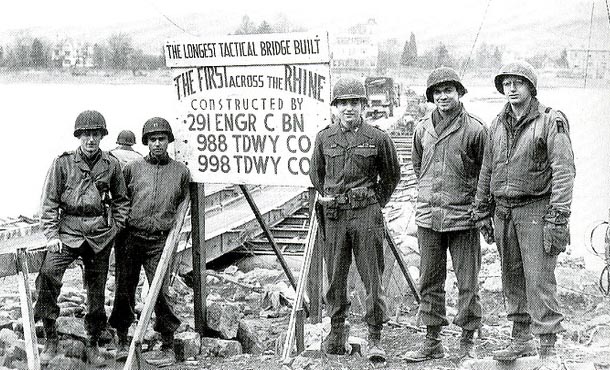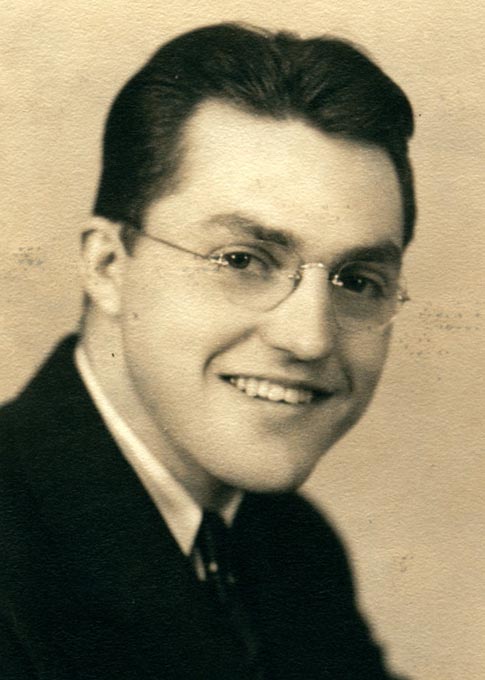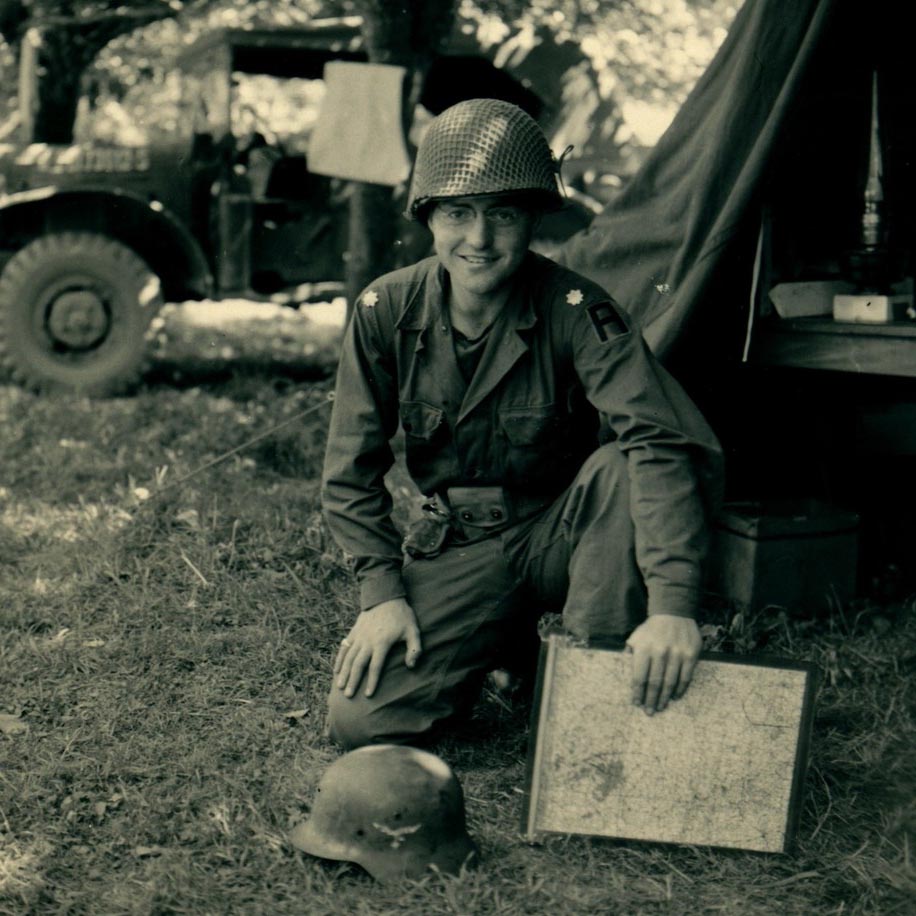
In this photo from his book “First Across the Rhine,” Pergrin, third from the right, stands in front of the bridge he and his unit constructed under heavy enemy fire during the Battle of Remagen — the longest such bridge constructed during World War II. IMAGE: RETIRED COL. THOMAS FOSNACHT
Civil engineering alumnus who helped create Nittany Lion Shrine also accomplished WWII veteran
Col. David E Pergrin, Class of 1940 president, served as commander of the most decorated combat engineering unit of World War II
10/24/2019
UNIVERSITY PARK, Pa. — In this special military appreciation Throwback Thursday, Penn State remembers and honors the life and achievements of Col. David E. Pergrin — a Penn Stater who played a key role in creating the Nittany Lion Shrine, and a veteran who served in one of the most decorated U.S. Army units of World War II.
In that role, Pergrin helmed the committee that commissioned one of Penn State’s most iconic and beloved symbols: a stone sculpture of a Pennsylvania mountain lion, known today as the Nittany Lion Shrine.
Although Pergrin’s leadership was indispensable to the creation of the shrine, he was not present at the statue’s dedication two years later, on Oct. 24, 1942, due to his mobilization with the U.S. Army.
At the time of the statue’s dedication, Pergrin was training the unit he would lead in combat: the 291st Engineer Combat Battalion. He had been named its commander two months earlier at the young age of 26, and under his leadership the 291st Battalion would play a critical role in the single largest battle waged by U.S. forces during World War II.
“Those damned engineers!’
As a result of his Penn State ROTC training, Pergrin was commissioned a second lieutenant in the Army Corps of Engineers upon graduation. In recognition of his engineering excellence and natural talent as a leader, Pergrin was entrusted with command of a significant combat unit that he led with distinction, ultimately rising to the rank of colonel.
Under Pergrin’s command, the 291st Battalion went on to become the single most decorated Army engineer unit of World War II, receiving the Presidential Unit Citation for “for extraordinary heroism and outstanding performance of duty in action.” Pergrin himself received the Silver Star for valor under fire and the Purple Heart for wounds received in combat, as well as receiving the Croix de Guerre from the French and Belgian governments.
The legacy of the 291st Battalion was established during two of the most influential battles of the war: the Battle of the Bulge and the Battle of Remagen, in which Pergrin and his unit’s efforts were indispensable to Allied victory.
During the Battle of the Bulge — the largest and costliest battle for American forces in World War II — an advancing wave of German Panzer tanks forced many Allied units to retreat. But, instead of falling back, Pergrin confronted the onslaught and personally directed the 291st Battalion to blow the vital bridges that allowed the Panzers to move through the heavily forested, hilly terrain.
In his book “First Across the Rhine,” written about his experiences in World War II and published in 1989, Pergrin recounted how the commander of the SS Panzer regiment was purported to have uttered in despair and frustration: “Those damned engineers! Those damned engineers!” The 291st Battalion was successful in blunting the German advance, forcing the regiment to abandon their tanks and helping turn the tide of the battle.
Three months later, Pergrin and the 291st Battalion would again play a key role in one of the most important battles of the war. The rapid advance of Allied forces had resulted in the capture of the only bridge still standing over the Rhine River: the Ludendorff Bridge at the German town of Remagen. Although this gave Allied forces a significant and unexpected advantage, it also made the bridge a target for an onslaught of German aircraft and artillery.
The 291st Battalion was the first Army engineer unit to arrive at the Battle of Remagen and, under heavy enemy fire, immediately began construction of a backup bridge in the expectation that the Ludendorff Bridge would eventually collapse, which it did. However, the replacement bridge constructed by the 291st Battalion permitted U.S. forces to move further into central German and hasten the end of the war.
The pontoon bridge constructed by the 291st Battalion — completed in only 32 hours, all under enemy fire — stretched 1,032 feet and was the single longest such bridge constructed during the war. All told, Pergrin and his unit built more than 70 bridges during the war, 19 of them constructed under enemy fire.
In addition to “First Across the Rhine,” Pergrin also chronicled his experiences during World War II in a second book, titled “Engineering the Victory: The Battle of the Bulge,” published in 2004. The courageous exploits of the 291st Battalion have also been the subject of multiple documentaries, including the History Channel’s “Unsung Heroes of WWII.”
Civilian life
Pergrin enjoyed a long and successful career as a railroad executive upon his return to civilian life. Putting his civil engineering degree to use, Pergrin went to work for the Pennsylvania Railroad, and later Penn Central, ultimately retiring as vice president and chief engineer. He was also appointed as an adviser to the Federal Rail Administration in 1978 by the U.S. Secretary of Transportation.
Outside of his work as an engineer, Pergrin was a husband, father, and noted and accomplished woodcarver. He wrote and published three guides to the art of woodcarving between 1984 and 1985, and was known to give hand-carved Nittany Lion statues as gifts to friends and family.
A lifelong Penn Stater, Pergrin was an active member of the Penn State Alumni Association and the 1988 recipient of Penn State’s Outstanding Engineer Award. Combining his love of woodcarving and Penn State, Pergrin also helped establish the annual William Rush Woodcarving Show held each year at Penn State Brandywine.
He also was a devoted volunteer, and often gave of his time to local charities in Delaware County, where he lived with his family for many years. Pergrin died on April 7, 2012, at the age of 94.
Penn State thanks David Pergrin for both his service to his University and his service to his country. This year’s Military Appreciation Week, from Nov. 8 to 16, will honor America’s “Greatest Generation” with a week-long series of campus events, including a football game, Veterans Day ceremony, speaker series and more. Visit militaryappreciation.psu.edu to learn more.





